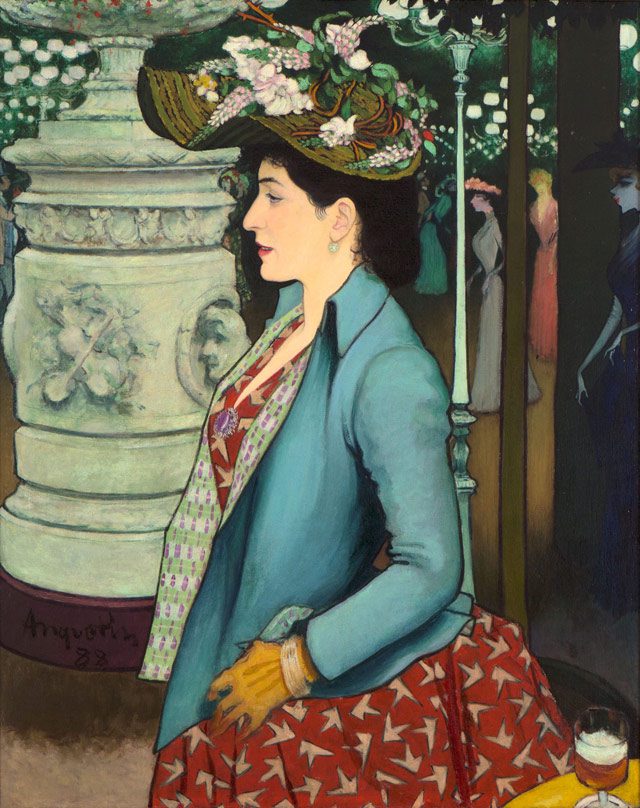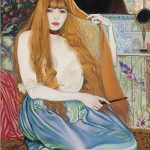
Cloisonnism wasn’t born in a vacuum; it was a direct response to the prevailing norms of 19th-century painting. Picture this: a group of artists tired of the realistic shading, tonal gradients, and the often rigid techniques that dominated Academic Painting. Instead of blending colors for a subtle transition, they opted for bold, flat areas of color, divided by thick, dark outlines. It was a shock to the system—and an exhilarating one at that!
This audacious art movement emerged in the late 1880s, led primarily by French artists Émile Bernard, Louis Anquetin, and Paul Gauguin. While the name Cloisonnism comes from the cloisonné technique used in enamel work (think metal borders separating vibrant enamel colors), the method itself was about as far from delicate as you could get. The thick black outlines and vibrant color fields rejected the naturalism that had defined Western painting for centuries. By simplifying forms and focusing on decorative, expressive colors, these artists created a whole new visual language.
Cloisonnism also reflected the influence of Japanese prints, which were flooding into Europe at the time. The simplicity and boldness of Japanese ukiyo-e prints, with their sharp lines and flat spaces of color, deeply resonated with artists like Gauguin, who saw a kind of purity in this approach. The simplicity of Cloisonnism was a bold, almost rebellious statement in an era of hyper-realistic art. It said, “We don’t need to be photographic to express the soul of a subject.”
Gauguin’s Role: Cloisonnism’s Most Daring Rebel
Paul Gauguin is a name you can’t ignore when discussing Cloisonnism. Though not the creator of the movement, he certainly became its most famous advocate. Gauguin, who would go on to influence countless artists like Picasso and Matisse, found the movement’s techniques liberating. Before Cloisonnism, Gauguin had dabbled in Impressionism, which he found lacking in its focus on fleeting moments and light.
What Cloisonnism gave Gauguin was the freedom to break away from traditional representations entirely. In fact, Gauguin once famously declared, “I shut my eyes in order to see.” This encapsulates the core of Cloisonnism—an inward vision rather than an external one. His works during his time in Pont-Aven, a small village in Brittany, are perfect examples of this bold break. Paintings like The Vision After the Sermon (1888) and Yellow Christ (1889) are iconic in their use of flat, vibrant color fields and dark, contouring lines.
Gauguin wasn’t merely painting what he saw—he was painting what he felt. The thick, dark outlines that separated one field of color from another felt more emotional, more immediate. His works during this period show a rawness that you don’t find in the polished realism of his contemporaries. This was a man who wasn’t just painting; he was declaring something new. And Cloisonnism gave him the language to do it.
The Bold, Flat Colors: Cloisonnism’s Hallmark
Cloisonnism made a huge splash because of its audacious use of flat colors. If you’ve ever seen a Cloisonnist painting, you’ll know what I mean. No subtle shading or smooth gradients—just unapologetic blocks of color staring you in the face. The technique was simple but powerful. These flat areas of color gave the subjects an almost spiritual dimension. When looking at a Gauguin or Bernard piece from this era, it’s hard not to feel like you’re seeing something beyond the material world.
But let’s break it down a little more. What makes this flatness so compelling? For starters, it’s an invitation to focus on the form and structure of the image without the distractions of light and shadow. When you remove the depth and volume traditionally created by shading, you’re left with something more symbolic, more iconic. It’s almost like looking at stained glass, where the focus is on narrative and meaning rather than realism.
The technique was especially impactful in religious scenes. Gauguin’s Yellow Christ is a great example. The flatness of the color reduces the figure to its essential form, making it more universal, more divine. It’s not about a specific person in a specific time and place—this is Christ for everyone, in every time. The simplification strips away the mundane and elevates the spiritual.
In essence, the flat colors weren’t just a stylistic choice—they were a philosophical one. By rejecting the realism of the external world, Cloisonnism allowed artists to delve deeper into the internal, emotional experience. This was art that felt as much as it looked.
Cloisonnism and Symbolism: A Perfect Pairing
Cloisonnism wasn’t just about painting styles; it was tied to something much deeper: Symbolism. The Symbolists were all about representing ideas and emotions rather than the physical world. They wanted to explore what lay beneath the surface—dreams, myths, spirituality—and Cloisonnism was the perfect vehicle for this exploration.
The stark division of colors and forms in Cloisonnism lent itself beautifully to symbolic art. Imagine how much more powerful a symbolic figure becomes when it’s stripped of unnecessary detail. You’re not distracted by the naturalistic depiction of a tree or a face; instead, you’re hit with the emotional or spiritual essence of it.
Émile Bernard’s Breton Women in the Meadow is a prime example. The painting isn’t about the individual women depicted but about the idea of spirituality, community, and devotion. The bold outlines and flat colors remove the distraction of physical detail, allowing you to focus on the meaning behind the figures.
This paring down of elements made Cloisonnism an ideal match for artists working within Symbolism. It wasn’t just about what was seen—it was about what was felt, remembered, or even dreamt. Cloisonnism, in many ways, became a visual language for the ineffable.
Cloisonnism vs. Impressionism: The Great Divide
At first glance, it might seem like Cloisonnism and Impressionism couldn’t be more different. Impressionists were obsessed with capturing the fleeting effects of light and color, while Cloisonnists couldn’t care less about that. But in a way, both movements were reacting to the same thing: the rigidity of traditional Academic Painting.
Impressionism sought to capture the world as it appeared in a specific moment—fleeting, fluid, constantly changing. Cloisonnism, on the other hand, wasn’t interested in a moment; it was after something timeless, something eternal. That’s why Cloisonnism’s use of bold outlines and flat colors feels more like a permanent declaration than Impressionism’s delicate observations.
It’s worth noting that several artists, like Gauguin, dabbled in both movements before fully committing to one. Gauguin’s earlier works show the influence of Impressionism, but as he grew more confident in his vision, he rejected its preoccupation with light and immediacy. Instead, he turned to Cloisonnism’s symbolic, timeless approach, which allowed for more personal expression and emotional depth.
So, while the two movements might seem at odds, they’re really just two sides of the same coin—two different ways of challenging the artistic status quo.
Cloisonnism’s Legacy: Impact on Modern Art
You might be wondering, “Why should I care about a niche art movement from the 1880s?” Well, Cloisonnism’s influence on modern art is undeniable. Many of the principles that Cloisonnists championed—simplified forms, bold outlines, flat colors—became essential building blocks for later movements like Fauvism and even Cubism.
Henri Matisse, for example, was heavily influenced by Cloisonnism’s use of flat colors. His works like The Red Room (1908) carry forward the same sense of bold color blocking, though with an even more playful and abstract approach. Without Cloisonnism’s radical break from tradition, it’s hard to imagine artists like Matisse or the later abstract painters taking the leaps they did.
Cloisonnism also had a major impact on graphic design. If you look at early 20th-century posters, especially the works of Toulouse-Lautrec or Alphonse Mucha, you’ll see echoes of Cloisonnism’s bold outlines and flat colors. These visual strategies became crucial for communicating ideas quickly and effectively in graphic design, where clarity and impact were key.
Even contemporary artists and designers owe a debt to Cloisonnism. The emphasis on form over detail, on emotional resonance over realism, remains a powerful tool for artists today. In a world where we’re bombarded with visual information, the clarity and impact of Cloisonnism’s aesthetic remain as relevant as ever.
Criticism of Cloisonnism: Too Simplistic or Revolutionary?
Of course, not everyone was on board with Cloisonnism when it first emerged. Some critics saw the movement as a regression, a simplification that stripped art of its technical finesse. They couldn’t see the deeper meaning behind the bold lines and flat colors and dismissed the works as amateurish or naive.
But that’s exactly where Cloisonnism’s genius lies. By stripping away the unnecessary, it forces you to focus on the core emotional or symbolic message. It’s not about technical mastery; it’s about communication, expression, and feeling. And let’s be honest, sometimes technical mastery can get in the way of that.
Cloisonnism was revolutionary because it dared to say that art doesn’t need to be complex to be meaningful. In fact, by simplifying forms and colors, it found new ways to express old ideas—ideas about spirituality, nature, and the human condition. And in doing so, it laid the groundwork for many of the boldest artistic movements of the 20th century.
Cloisonnism’s Timeless Impact
Cloisonnism may have been a short-lived movement, but its impact on the art world was profound. By rejecting the conventions of realism and embracing bold, flat colors and strong outlines, Cloisonnists like Gauguin, Bernard, and Anquetin paved the way for modern art. Their work not only influenced later movements like Fauvism and Cubism but also found its way into graphic design and popular culture.
So, the next time you see a modern painting with bold lines and striking colors, remember that it all started with a group of artists in the 1880s who weren’t afraid to do something different. Cloisonnism may not be as famous as Impressionism or Cubism, but its legacy lives on in the way we see and create art today.






